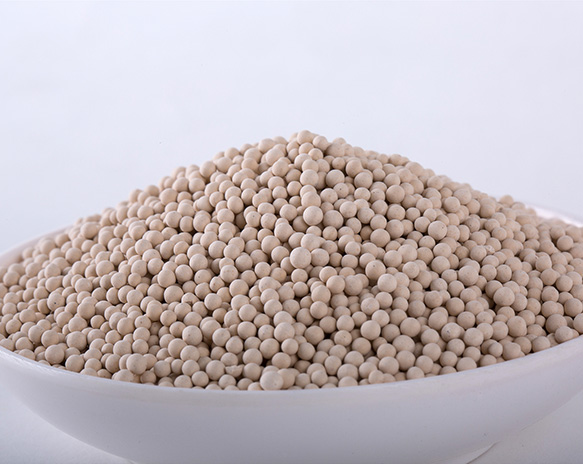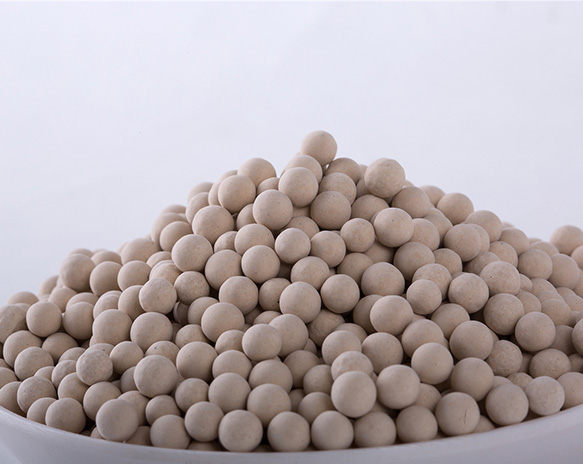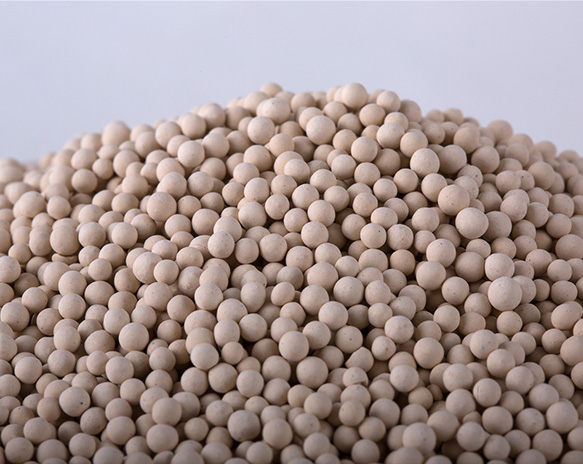







Commonly used molecular sieve models in the gas industry:
▪Square sodium type, e.g.type A: potassium A(3A),sodium A(4A),calcium A(5A);
▪Octahedral, e.g.type X: calcium X(10X),sodium X(13X)and type Y:sodium Y,calcium Y;
▪mercerized(type-M): High silica type zeolites such as ZSM-5.
Molecular sieves are silica-aluminate compounds with a cubic lattice.Molecular sieve has a uniform micropore structure, and its pore diameter is uniform. These pores can adsorb molecules smaller than their diameter to the interior of the pore cavity, and have a preferential adsorption ability for polar molecules and unsaturated molecules,so it can separate molecules with different degrees of polarity, different degrees of saturation, different molecular sizes and different boiling points, that is, it has the role of "screening" molecules, therefore, it is called molecular sieve.
In a narrow sense, molecular sieves are crystalline silicates or silica-aluminate salts, consisting of silica-oxygen tetrahedra or aluminum-oxygen tetrahedra connected by oxygen-bridge bonding to form a system of pores and cavities of molecular size (usually 0.3~2.0 nm), which has the property of sieving molecules. However, with the in-depth study of molecular sieve synthesis and application, researchers have discovered phospho-aluminate molecular sieves, and the skeleton elements of molecular sieves (silicon or aluminum or phosphorus) can also be replaced by B, Ga, Fe, Cr, Ge, Ti, V, Mn, Co, Zn, Be, and Cu, etc., and the size of its pores and cavities can reach more than 2 nm, so molecular sieves can be divided into silica-aluminum class according to the composition of the skeleton elements. molecular sieve, phosphorus aluminum molecular sieve and skeleton heteroatomic molecular sieve; according to the pore size division, pore size less than 2 nm, 2~50 nm and more than 50 nm molecular sieve are called microporous, mesoporous and macroporous molecular sieve, respectively. Due to the large pore size, it becomes a good carrier for larger size molecular reaction, but the pore wall of mesoporous material is amorphous, resulting in its hydrothermal stability and thermal stability can not yet meet the harsh conditions required for petrochemical applications.
Because of the lower valence and ionic radius of the metal ions and water in the chemical state, the water molecules in the heating of the continuous loss, but the structure of the crystal skeleton remains unchanged, the formation of a number of the same size of the cavity, the cavity and there are many of the same diameter of the microporous connected to the diameter of these tiny holes of uniform size, than the diameter of the pore diameter of the molecules adsorbed to the inside of the hole to the molecules, and the molecules than the pore size of the molecules excluded. Therefore, it can separate molecules with different shapes and diameters, molecules with different polarities, molecules with different boiling points and molecules with different degrees of saturation, i.e., it has the function of "sieving" molecules, so it is called molecular sieve. At present, molecular sieve is widely used in metallurgy, chemical industry, electronics, petrochemical industry, natural gas and other industries.
Molecular sieves, which have a very high capacity for absorbing moisture (and are therefore widely used as desiccants), are used in the purification of gases and should be stored in such a way as to avoid direct exposure to air. The molecular sieve which has been stored for a long time and has absorbed moisture should be regenerated before use. The molecular sieve avoids oil and liquid water. When used, it should avoid contact with oil and liquid water as much as possible. The gases drying in industrial production are air, hydrogen, oxygen, nitrogen, argon and so on. Two adsorption driers are connected in parallel, one of them works while the other one can be regenerated at the same time. Work and regenerate alternately with each other to ensure the continuous operation of the equipment. The dryer works at 8-12℃, and regenerates by flushing gas at 350℃. Different sizes of molecular sieve regeneration temperature is slightly different. The molecular sieve has good catalytic effect on certain organic gas phase reactions.
Also known as zeolite or zeolite, is a crystalline alumino-silicate, the crystal structure of the regular and uniform pore, pore size for the molecular size of the order of magnitude, it only allows the diameter of the molecules smaller than the pore size into the molecules, so the molecules in the mixture according to the size of the mixture to be sieved. Therefore, it is called molecular sieve. As early as more than 200 years ago, B. Kronstedt the first aluminum silicate named zeolite, the chemical composition of the general formula for Where M and n are metal ions and their valence; x is the number of molecules of silica; y is the number of molecules of water; p is the number of atoms of aluminum; q is the number of atoms of silicon. Molecular sieves are used as solid adsorbents in the chemical industry, and the substances adsorbed by them can be desorbed, and molecular sieves can be regenerated after use. It is also used for drying, purifying, separating and recycling of gases and liquids.Starting from 1960s, it is used as cracking catalyst in petroleum refining industry, and now it has been developed many kinds of molecular sieve catalysts which are suitable for different catalytic processes.
There are two types of molecular sieves: natural zeolites and synthetic zeolites.
①Most natural zeolites are formed by the reaction of volcanic tuffs and tuffaceous sedimentary rocks in a marine or lacustrine environment.At present, more than 1000 kinds of zeolite ore have been found, the more important 35 kinds, the common clinoptilolite, mercerite, zeolite and rhombozeolite.They are mainly distributed in the United States, Japan, France and other countries, China has also found a large number of mercerized zeolite and clinoptilolite deposits, Japan is the largest natural zeolite mining country.
②Since natural zeolite is limited by resources, synthetic zeolite has been widely used since the 1950s.
Commercial molecular sieves commonly used prefix numbers to classify molecular sieves with different crystal structures, such as 3A, 4A, 5A molecular sieves. Type 4A is class A in the table, aperture 4A. A type molecular sieve containing Na+ is denoted as NA-A. If Na+ is replaced by K+, the pore size is about 3A, that is, 3A type molecular sieve. If more than 1/3 of Na+ in NA-A is replaced by Ca2+, the pore size is about 5A, that is, 5A type molecular sieve.
3A Molecular Sieve
3A molecular sieve refers to potassium A-type silicaluminate, 3A molecular sieve can adsorb molecules with A critical diameter not greater than 3A, industrial often used for unsaturated hydrocarbon gas (such as ethylene, propylene, butadiene, etc.)
Appliance:
▪Refrigerant drying
▪Cracked gas drying
▪Natural gas drying
▪Dehydration of gas or air in insulating glass
▪Dehydration of methanol, ethanol and other polar compounds
▪Dehydration of unsaturated hydrocarbons (e.g. ethylene, propylene, butadiene)
4A Molecular Sieve
4A molecular sieve refers to sodium A-type silica-aluminate, 4A molecular sieve can adsorb molecules whose critical diameter is not larger than 4A, and it can adsorb water, methanol, ethanol, hydrogen sulfide, sulfur dioxide, carbon dioxide, ethylene, propylene and so on, and any molecules that can be adsorbed on 3A-type molecular sieve can be adsorbed on 4A-type.
Appliance:
▪Drying of refrigerant and drying of air in valves
▪Removal of carbon dioxide, ammonia, methanol from gas streams
▪Drying and purification of hydrocarbons such as natural gas, LPG, air, noble gases and atmospheres
▪Drying of electronic components, pharmaceuticals, foodstuffs, etc.
5A Molecular Sieve
5A molecular sieves are calcium A silica-aluminate.5A molecular sieve can adsorb molecules whose critical diameter is not larger than 5A, and all molecules that can be adsorbed on 3A and 4A type molecular sieve can be adsorbed on 5A type.
Appliance:
▪Separation of n-isomerized alkanes in the petrochemical industry
▪Variable pressure adsorption process for the purification of hydrogen, oxygen.
▪Drying and purification of oil, natural gas and other industrial gases, removal of impurities such as water, carbon dioxide and sulfur from gas streams.
13X Molecular Sieve
13X molecular sieve is an alkali metal silica-aluminum salt. The sodium salt form of 13X molecular sieve has an effective pore size of 10 angstroms and adsorbs molecules not larger than 10 angstroms. It can be used as a catalyst carrier, water and carbon dioxide co-adsorption, water and hydrogen sulfide gas co-adsorption, and is mainly used in pharmaceuticals and drying of air compression systems.
Appliance:
▪Removal of hydrogen sulfide and mercaptans from hydrocarbons and natural gas.
▪Removes carbon dioxide and moisture from air (air pre-purification) and other gases.
▪Separates oxygen from air, protects catalysts, and removes oxides from hydrocarbons.